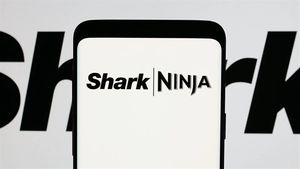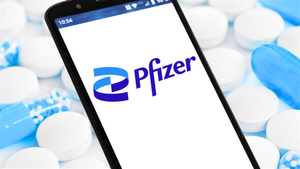- VRDN-003 clinical data exceeded expectations with extended half-life of 40-50 days, 4-5x longer than VRDN-001, supporting a potential best-in-class, low-volume, less frequent, self-administered subcutaneous therapy for thyroid eye disease (TED) -
- Data support VRDN-003 dosing as infrequently as once every eight weeks and is expected to reach exposure levels associated with robust clinical response in earlier trials of VRDN-001 in TED patients -
- Pivotal clinical development of subcutaneous VRDN-003 in TED patients expected to initiate mid-2024 pending alignment with regulatory authorities -
- Viridian to host investor conference call and webcast today at 8:00am ET -
Viridian Therapeutics, Inc. (NASDAQ: VRDN), a biotechnology company focused on discovering and developing potential best-in-class medicines for serious and rare diseases, today announced the selection of VRDN-003 as its lead subcutaneous (SC) program for thyroid eye disease (TED) based on positive data from a Phase 1 clinical study in healthy volunteers. The data showed that VRDN-003 has an extended half-life of 40-50 days, about 4-5 times longer than VRDN-001 and based upon comparisons of publicly disclosed data, significantly longer than other first generation anti-insulin-like growth factor-1 receptor (IGF-1R) antibodies. VRDN-003 was well tolerated and exhibited sustained pharmacodynamics supporting its development as a potential best-in-class, more convenient, less frequent, low-volume, self-administered, subcutaneous IGF-1R therapy for patients with TED.
“The VRDN-003 data exceeded our expectations as a potential best-in-class treatment option for patients affected by TED and support advancing dosing regimens as infrequently as once every eight weeks, which we believe could be transformative for TED patients who currently only have access to intravenous (IV) IGF-1R therapy,” said Steve Mahoney, President and CEO of Viridian Therapeutics. “The data reinforce our confidence in VRDN-003’s rapid development as a low-volume, self-administered, subcutaneous product. Given VRDN-003’s comparable pharmacology with VRDN-001, which has already generated compelling clinical data in TED patients, we are excited about the clinical potential of this program for patients and our ability to rapidly move toward pivotal development.”
VRDN-003 Results
VRDN-003 is a monoclonal antibody that acts as a full antagonist of IGF-1R, a clinically and commercially validated target for TED. VRDN-003 utilizes the same binding domain as VRDN-001 and is engineered with three amino acid changes to the Fc region designed to extend the half-life of the parent antibody, and therefore potentially enabling less frequent and more convenient dosing. VRDN-003 is designed to maintain the clinical response of VRDN-001 IV while significantly increasing patient convenience.
- Study Design: VRDN-003 was dosed in four single dose cohorts of healthy volunteers at a concentration of 150 mg/ml receiving 5 mg/kg IV (n=4), 300 mg SC (n=6), 15 mg/kg IV (n=4) and 600 mg SC (n=6). A fifth cohort of two doses of VRDN-003 (n=4) is ongoing.
-
Summary of Results:
- Extended Half Life: VRDN-003 pharmacokinetics data showed an extended half-life of 40-50 days, which is a 4-to-5-fold increase over the half-life of VRDN-001 (which showed a half-life of 10-12 days).
- Prolonged Pharmacodynamics (PD): Following a single subcutaneous dose of VRDN-003, IGF-1 serum levels increased approximately 4-fold at peak. This was consistent with the increases in IGF-1 levels that have been shown in the clinic following a single dose of VRDN-001 SC and IV. IGF-1 is a PD biomarker for IGF-1R target engagement. IGF-1R inhibition by an anti-IGF-1R antibody demonstrated an increase in serum levels of its natural ligand IGF-1.
- Well Tolerated: VRDN-003 was well tolerated in all subjects with no serious adverse events. All treatment-related, treatment-emergent adverse events were grade 1 (mild). In the reported dataset, no antidrug antibodies (ADAs) were detected.
-
Dosing Flexibility for Pivotal Development: VRDN-003 modeling demonstrates dosing flexibility for the program’s anticipated global pivotal development.
- Q8W (dosing once every 8 weeks): Modeled dose schedule is predicted to achieve Cmin and Cavg exposures seen for 3 mg/kg VRDN-001 IV.
- Q4W (dosing once every 4 weeks): Modeled dose schedule is predicted to achieve Cmin exposures seen for 10 mg/kg VRDN-001 IV and exceed the Cavg exposures seen for 3 mg/kg by a factor of 2.
- Q2W (dosing once every 2 weeks): Modeled dose schedule is predicted to exceed Cmin exposures seen for 20 mg/kg VRDN-001 IV and the Cavg exposures seen for 10 mg/kg VRDN-001 IV.
“The shared binding domain and pharmacology of VRDN-003 with VRDN-001 allow us to leverage the clinical activity of VRDN-001 IV at different exposure levels to confidently select doses for VRDN-003 that we expect to demonstrate an impactful clinical response,” said Tom Ciulla, Viridian’s Chief Development Officer. “We are enthusiastic about delivering a product with highly attractive, low-volume subcutaneous dosing schedules that we firmly believe will be preferred by patients.”
Based on the data being reported today, VRDN-003 has been selected as Viridian’s go-forward candidate for subcutaneous development. We expect to initiate the VRDN-003 pivotal program in mid-2024, pending alignment with regulatory authorities. Based on these positive results and the expected development timeline for VRDN-003, both VRDN-001 SC and VRDN-002 SC development have been deprioritized.
VRDN-001 SC and VRDN-002 Results
VRDN-001 SC is a subcutaneous formulation of the same antibody being evaluated as an IV product candidate in the company’s ongoing Phase 3 THRIVE and THRIVE-2 clinical trials. The Phase 1 healthy volunteer study included a cohort of the SC formulation of VRDN-001 at a concentration of 150 mg/ml dosed in two single dose cohorts of healthy volunteers either receiving 3.5 mg/kg IV (n=8) or 300mg SC (n=8). SC data showed an expected half-life of 10-12 days. Q1W dosing of VRDN-001 SC was modeled to achieve or exceed exposures shown for 10 mg/kg VRDN-001 IV and would be expected to achieve comparable clinical response to VRDN-001 10 mg/kg IV. VRDN-001 SC also showed an increase in IGF-1 levels similar to VRDN-001 IV and VRDN-003 SC. VRDN-001 SC was well tolerated in all subjects with no serious adverse events. All treatment-related, treatment-emergent adverse events were grade 1 (mild) and grade 2 (moderate).
VRDN-002 is a different and novel monoclonal antibody targeting IGF-1R as compared to VRDN-001 or VRDN-003. Similar to VRDN-003, VRDN-002 was engineered to have an extended half-life to allow for less frequent dosing. VRDN-002 SC was dosed at a concentration of 150 mg/ml in two single dose cohorts of healthy volunteers, either receiving 3.5 mg/kg IV (n=8) or 300 mg SC (n=8). Healthy volunteer data for VRDN-002 showed an extended half-life of 43 days as previously disclosed. VRDN-002 also showed a prolonged pharmacodynamic effect and increased IGF-1 levels, but the magnitude of increase was not as great as with VRDN-003 or VRDN-001. VRDN-002 was well tolerated in all subjects with no serious adverse events. All treatment-related, treatment-emergent adverse events were grade 1 (mild). No ADAs were detected.
Next Steps for the Development of VRDN-003 in TED
Based on the results reported today, the company expects to initiate global pivotal clinical trials of VRDN-003 in mid-2024 with planned trials in both active and chronic TED patients pending alignment with regulatory authorities.
“We view the VRDN-003 data as a crucial step forward for TED patients,” said Mr. Mahoney. “Based on the data, we expect that VRDN-003 could be a leader in the large TED commercial market that may be poised for expanded growth with a more convenient, less frequent, at-home, self-administered, subcutaneous product. We plan to move forward rapidly and will provide additional details about our trial design and development plans in the first half of 2024.”
Conference call and webcast information
The Company will host a conference call today at 8:00 a.m. ET to discuss the data for Viridian’s lead selection for the IGF-1R subcutaneous program. The dial-in number for the conference call is 1-888-330-3622 for domestic participants and 1-646-960-0662 for international participants. The conference ID is 3961606.
A live webcast of the conference call can be accessed through the “Events” page in the Investors section of the Viridian Therapeutics website. Following the live webcast, an archived version of the call will also be available on the website.
About Viridian’s Thyroid Eye Disease Pipeline (VRDN-001 and VRDN-003)
Viridian’s lead product candidate, VRDN-001, is a differentiated monoclonal antibody targeting insulin-like growth factor-1 receptor (IGF-1R), a clinically and commercially validated target for the treatment of thyroid eye disease (TED). In preclinical studies, VRDN-001 was shown to be a full antagonist of IGF-1R, with more complete receptor blockade than other anti-IGF-1R antibodies, including the only currently approved TED therapy. Data from the Phase 2 portion of the trial established clinical proof-of-concept for VRDN-001 in patients with active and chronic TED. VRDN-001 was generally well tolerated in the trial.
The THRIVE and THRIVE-2 Phase 3 clinical trials in patients with active and chronic TED are ongoing.
Viridian’s goal is to advance VRDN-001 as a best-in-class IV therapy followed by VRDN-003 as a first- and best-in-class SC therapy for the treatment of TED. The company has selected VRDN-003 as its lead SC program for TED based on positive data from its Phase 1 clinical study in healthy volunteers and expects to initiate global pivotal development of VRDN-003 with planned trials in both active and chronic TED patients pending alignment with regulatory authorities.
About TED
TED is a serious and debilitating rare autoimmune disease that causes inflammation within the orbit of the eye that can cause double vision, pain, and potential blindness. TED is a progressive disease consisting of an initial active phase, followed by a transition to a secondary chronic phase. More than 50,000 and 200,000 people are estimated to suffer from active and chronic TED, respectively, in the United States and Europe.
About Viridian Therapeutics
Viridian is a biopharmaceutical company focused on engineering and developing potential best-in-class medicines for patients with serious and rare diseases. Viridian’s expertise in antibody discovery and engineering enables it to develop differentiated therapeutic candidates for previously validated drug targets in commercially established disease areas.
Viridian is advancing multiple candidates in the clinic for the treatment of patients with TED. The company is conducting two global Phase 3 clinical trials (THRIVE and THRIVE-2) to evaluate the safety and efficacy of VRDN-001 in patients with active and chronic TED. Viridian’s goal is to advance VRDN-001 as a best-in-class IV therapy followed by VRDN-003 as a first- and best-in-class SC therapy for the treatment of TED. In addition to its TED portfolio, Viridian is advancing a novel portfolio of neonatal Fc receptor (FcRn) inhibitors, VRDN-006 and VRDN-008, which has the potential to be developed in multiple autoimmune diseases. Viridian is also developing additional preclinical assets in autoimmune and rare diseases.
Viridian is based in Waltham, Massachusetts. For more information, please visit www.viridiantherapeutics.com. Follow Viridian on LinkedIn and X.
Forward-Looking Statements
This press release contains forward-looking statements within the meaning of the Private Securities Litigation Reform Act of 1995. These statements may be identified by the use of words such as, but not limited to, “anticipate,” “believe,” “continue,” “could,” “estimate,” “expect,” “intend,” “may,” “might,” “plan,” “potential,” “predict,” “project,” “should,” “target,” “will,” or “would” or other similar terms or expressions that concern our expectations, plans and intentions. Forward-looking statements are neither historical facts nor assurances of future performance. Instead, they are based on our current beliefs, expectations, and assumptions. Forward-looking statements include, without limitation, statements regarding: the therapeutic potential and utility, efficacy and clinical benefits of VRDN-003 for Thyroid Eye Disease (TED); the expected exposure levels of VRDN-003; the safety profile of VRDN-003; the potential dosing frequency for VRDN-003; trial designs, clinical development plans and timing for VRDN-003, including the global pivotal clinical trials of VRDN-003 in active and chronic TED patients; the expected attractiveness of VRDN-003 and convenience for patients; and anticipated work with regulatory authorities. New risks and uncertainties may emerge from time to time, and it is not possible to predict all risks and uncertainties. No representations or warranties (expressed or implied) are made about the accuracy of any such forward-looking statements. Such forward-looking statements are subject to a number of material risks and uncertainties including but not limited to: the potential efficacy and safety of VRDN-001, VRDN-002, and VRDN-003 for the treatment of TED; the potential for VRDN-006 and VRDN-008; the relationship between the results from the positive data from completed or ongoing clinical trials and the results of ongoing or future clinical trials; the timing, progress and plans for our ongoing or future research, pre-clinical and clinical development programs; trial protocols for ongoing clinical trials; expectations regarding the timing for IND filings; expectations regarding the timing for enrollment and data; uncertainty and potential delays related to clinical drug development; the duration and impact of regulatory delays in our clinical programs; the timing of and our ability to obtain and maintain regulatory approvals for our therapeutic candidates; manufacturing risks; competition from other therapies or products; estimates of market size; other matters that could affect the sufficiency of existing cash, cash equivalents and short-term investments to fund operations; our financial position and its projected cash runway; our future operating results and financial performance; the clinical utility of our therapeutic candidates and our intellectual property position; the timing of pre-clinical and clinical trial activities and reporting results from same, including those risks set forth under the caption “Risk Factors” in our Quarterly Report on Form 10-Q filed with the Securities and Exchange Commission (SEC) on November 13, 2023 and other subsequent disclosure documents filed with the SEC. Any forward-looking statement speaks only as of the date on which it was made. Neither the Company, nor its affiliates, advisors, or representatives, undertake any obligation to publicly update or revise any forward-looking statement, whether as a result of new information, future events or otherwise, except as required by law. These forward-looking statements should not be relied upon as representing the Company’s views as of any date subsequent to the date hereof.
View source version on businesswire.com: https://www.businesswire.com/news/home/20231218302697/en/
Contacts
Louisa Stone, 617-272-4604
Manager, Investor Relations
IR@viridiantherapeutics.com





